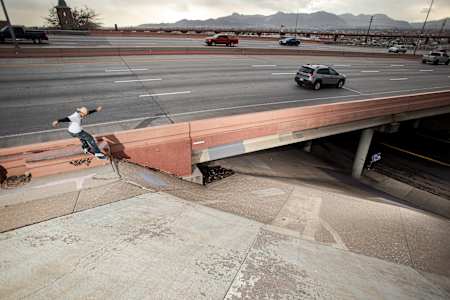Skateboarding
Skateboarding
Skateboarding – a glossary
Skateboarding is a language all to itself; here’s your guide to getting to grips with the terms and idioms unique to the culture.

A skateboard is made up of the wooden deck, upon which the skater stands, and the trucks, which operate as steering axles. On those trucks, there are four wheels, each with a pair of eight ball-bearing races countersunk into the core of the wheel, allowing the skaters to hit those high speeds required to leap across great distances or high in the air. Decks are traditionally made from seven individual veneers of Canadian maple, and most modern decks have both a Nose and Tail at the front and back of the board, respectively. The graphic design of the base laminate is purely aesthetic but has spawned some famous imagery and is a sub-culture all of its own.
Trucks are bolted to the base of the deck and consist of a baseplate from which is suspended the hanger (you may think of the hanger as the axle, although the axle itself lies within) by a threaded vertical kingpin. On either side of where the kingpin passes through the hanger are found two rubber bushings which give the skateboard its liquid steer. That’s it: a modern example of perfectly-designed, minimalist functionality.
01
Stance and orientation
Like its older and younger sister boardsports of surfing and snowboarding, skateboards are ridden in a combat stance, which is to say, one foot in front of the other as seen in martial arts. The preference is arbitrary but instinctive. Those who lead with the left foot are known as ‘regular’-footed, and right-leaders are ‘goofy’-footed. There is nothing to suggest either stance confers any advantage, and most skateparks have an element of symmetry to reflect that. The terms ‘Frontside’ and ‘Backside’ are borrowed from surfing and refer to the direction of the turn while standing sideways. Fakie just means rolling backwards.
Switchstance
Not so much a trick as an inversion of form, skateboarding ‘switch’ means riding in the opposite direction of one’s preferred combat stance. Recreating any move switchstance is the skateboarding equivalent of learning how to play golf the other way around, but with much more dangerous consequences from any errors arising from miscalculation.
02
The tricks
- Ollie: The discovery in the late 1970s that striking the kicktail off the ground allowed the skateboard to get airborne without grabbing it revolutionised the lexicon of trick possibility.
- Nollie: A reversal of the Ollie in which the nose of the board instead of the tail becomes the impact lever.
- Flip tricks: Tricks which involve flipping the board in the air using various techniques.
- Grinds: Riding along the rim of the bowl on the axles (‘trucks’) alone.
- Slides: Sliding along the rim of the bowl on the underside of the board (‘deck’) itself.
- Inverts: Sometimes known as handplants, the skateboarder plants a hand on the rim while momentarily going fully upside-down.
- Aerials: Sometimes known as airs, these involve a combination of grabs and spins in the air above the rim (‘coping’), which edges the vertical riding surfaces of the park.
- Blunts: A gravity-defying stall above the coping where only the tail of the board remains in momentary contact with the lip of the bowl.
- Transfers: A hugely courageous move in which the skateboarder takes off from one plane of movement and lands on another, like jumping over sand dunes. Requires total control.
03
How did the Ollie change skateboarding's 'Tricktionary'?
Named after its inventor Alan ‘Ollie’ Gelfand, the Ollie is the building block of today’s skateboarding. A no-handed air achieved by striking the tail of the board off the ground and then guiding the rebound through the air just by foot traction, the Ollie evolved into a myriad of variations which form the basis of today’s skateboarding. Broadly speaking, there are two axes of tricks which the Ollie allows for in mid-air: Flips, in which the board is spun in complete revolution, and Shove-Its, in which the board changes direction underfoot by either 180 or 360 degrees. Between the two axes involved, most permutations of the two have now been explored by skateboarders pushing the boundaries of possibility so a vast combination of Flip and/or Shove-It combinations are now achievable- but some are more challenging than others!
Be sure to download the free Red Bull TV app and watch unmissable skate action on all your devices!






